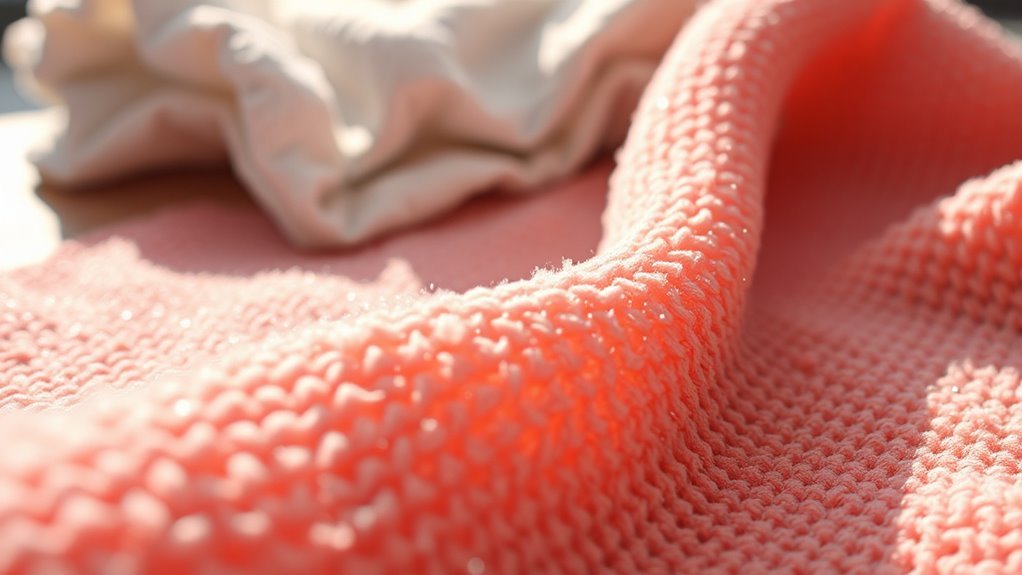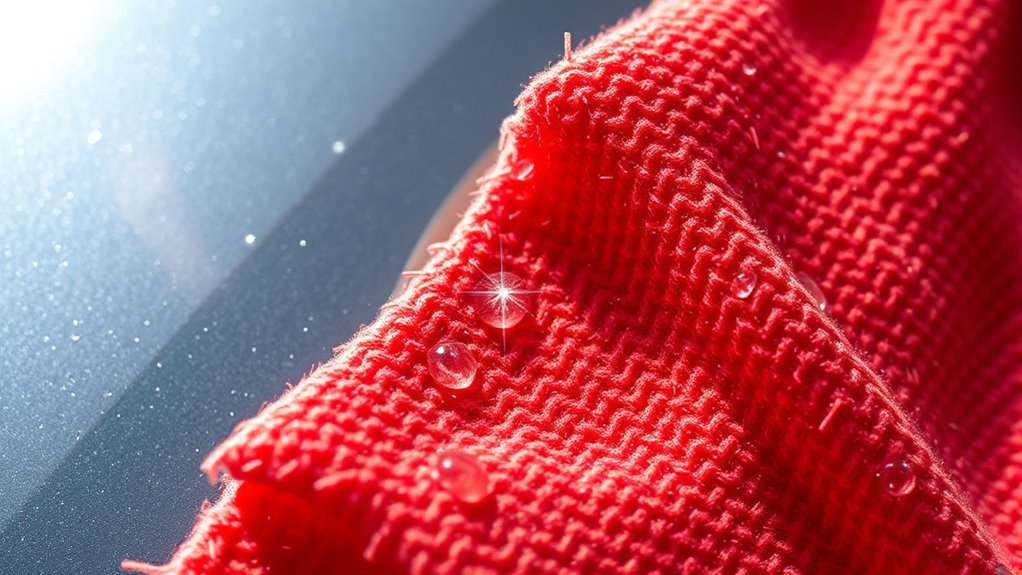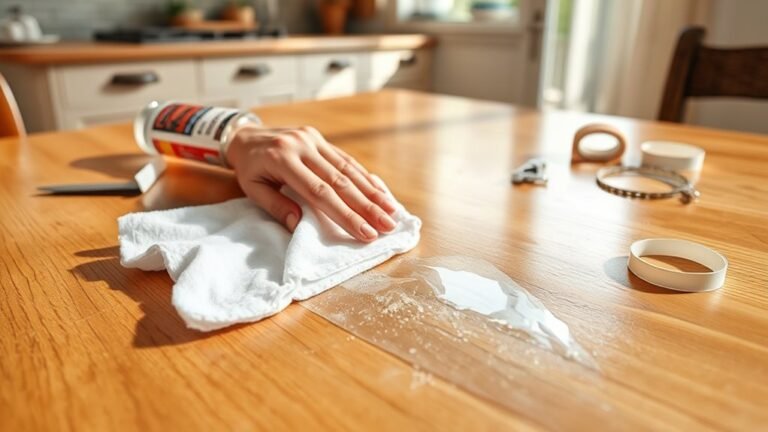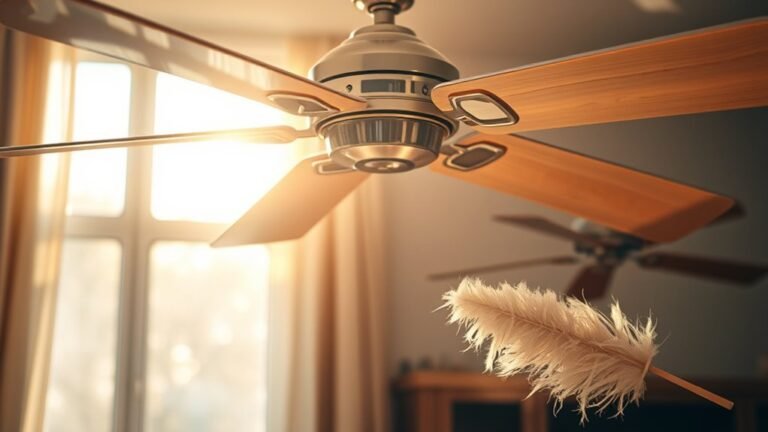The Magic of Microfiber: Why It’s a Cleaning Game-Changer
Microfiber is made of ultra-fine synthetic fibers that trap dirt and grime better than traditional cloths, making your cleaning faster and more efficient. Its dense weave and electrostatic charge attract particles without harsh chemicals, saving you effort and protecting the environment. Microfiber lasts longer, reducing waste and cutting down on cleaners you need. It’s not just practical—it’s a smarter, eco-friendly choice you’ll appreciate. Keep exploring to discover how to get the most from microfiber every time.
What Is Microfiber Made Of?

Although you might not realize it, microfiber is made from extremely fine synthetic fibers, usually a blend of polyester and polyamide (nylon). This unique microfiber composition allows the fibers to be thinner than a human hair—about one-fiftieth the diameter—giving you unmatched cleaning power. These microfiber fibers are woven tightly together, creating a material that’s lightweight, durable, and flexible. When you use microfiber cloths, you’re harnessing the strength of this advanced composition, making cleaning easier without harsh chemicals. This freedom to clean efficiently and sustainably is why microfiber has become a favorite for so many. Understanding the microfiber composition gives you insight into why it works so well, empowering you to choose cleaning tools that match your lifestyle and values.
How Microfiber Attracts and Traps Dirt
The secret to microfiber’s cleaning power lies in its structure, which lets it attract and trap dirt like a magnet. When you use microfiber, its fine fibers create a powerful dirt attraction that pulls grime away from surfaces. The unique trapping mechanism holds dirt deep inside, preventing it from being spread around.
| Feature | Effect |
|---|---|
| Ultra-fine fibers | Increase surface area |
| Electrostatic charge | Enhances dirt attraction |
| Split fibers | Trap particles efficiently |
| Dense weave | Holds dirt securely |
With this design, you get freedom from constant re-cleaning. Microfiber works hard to keep your space spotless, freeing you to focus on what really matters.
Advantages of Using Microfiber Over Traditional Cloths

When you switch to microfiber cloths, you’ll notice they clean more effectively than traditional ones, thanks to their fine fibers and unique design. These cloths grab dirt and dust like a magnet, requiring less effort and time from you. Plus, they’re eco friendly options since you’ll use fewer disposable wipes and reduce waste. Microfiber is also durable, meaning you can wash and reuse them countless times without losing their power. This makes them cost effective solutions that save you money in the long run. Choosing microfiber means you’re taking control—cutting down on cleaning hassle and environmental impact while enjoying superior results. It’s a simple change that gives you more freedom to focus on what matters.
Microfiber’s Role in Reducing Chemical Use
Switching to microfiber cloths not only boosts your cleaning efficiency but also lets you cut back on harsh chemicals. These cloths’ unique fibers trap dirt and bacteria effectively, so you don’t need to rely on heavy chemical cleaners. By embracing microfiber, you take control over your environment, reducing exposure to toxins and supporting sustainable cleaning practices. This chemical reduction means fewer pollutants enter your home and the water system, giving you freedom from harsh substances. Plus, with less chemical waste, you’re making a conscious choice to protect the planet. Microfiber’s ability to clean with just water or minimal detergent empowers you to keep spaces spotless while embracing a cleaner, greener lifestyle—making it a true game-changer for those who seek both efficiency and freedom.
Best Practices for Cleaning With Microfiber

Mastering just a few key techniques can make your microfiber cleaning more effective and long-lasting. Start by dampening your cloth slightly; microfiber works best when it traps dirt and dust with a bit of moisture. Avoid using fabric softeners or bleach, as they can damage fibers and reduce absorbency. When tackling tough spots, use gentle, circular motions rather than scrubbing harshly to protect surfaces and fibers alike. Regularly shake out or vacuum the cloth to remove debris before washing. These microfiber maintenance tips help preserve the cloth’s cleaning power. Remember, using the right microfiber cleaning techniques not only boosts your cleaning efficiency but also gives you the freedom to ditch harsh chemicals, making your routine safer and more sustainable.
Caring for and Maintaining Microfiber Cloths
To keep your microfiber cloths in top shape, you’ll want to follow some simple washing tips and drying best practices. Avoid using fabric softeners or bleach, as they can damage the fibers and reduce effectiveness. Taking care to wash and dry them properly will help your cloths last longer and perform better every time.
Washing Tips
Although microfiber cloths are durable, you’ll want to handle them with care during washing to maintain their effectiveness. Different microfiber types and microfiber applications can influence how you clean them, so treat each cloth accordingly. To keep your cloths in top shape, follow these washing tips:
- Use mild detergent without bleach or fabric softeners, which can clog fibers.
- Wash separately or with other microfiber items to prevent lint transfer.
- Opt for cold or warm water to protect the fabric’s structure.
- Avoid ironing, as high heat damages the delicate fibers.
Drying Best Practices
Three key drying practices can help you preserve the quality and longevity of your microfiber cloths. First, opt for air drying whenever possible. It’s gentle and maintains the fibers’ integrity better than high heat. Second, if you choose to use a dryer, select a low-heat or no-heat setting to maximize drying efficiency without risking damage. Avoid fabric softeners or dryer sheets, as they reduce the cloth’s absorbency. Finally, give your microfiber space to dry by laying it flat or hanging it up, which speeds up drying and prevents mildew. By mastering these drying techniques, you’ll keep your microfiber cloths in top shape, freeing you to clean effectively without worrying about premature wear or loss of performance.
Avoiding Damage
Since microfiber cloths are designed for durability, you might think they can handle anything—but improper care can quickly reduce their effectiveness. To maintain microfiber durability and guarantee microfiber safety, you need to treat these cloths right. You want them to last and perform at their best, without damage or loss of quality.
Here’s how to avoid damage:
- Wash separately from linty fabrics to prevent clogging fibers.
- Skip fabric softeners and bleach, as they break down microfiber strength.
- Use gentle detergents and cold or warm water to protect fibers.
- Air dry or tumble dry on low heat to preserve microfiber durability.
Common Household Uses for Microfiber Products
When you want to keep your home spotless without using harsh chemicals, microfiber products offer an effective and gentle solution. You can rely on them for window cleaning, leaving glass streak-free and crystal clear without the need for sprays. Dusting furniture becomes effortless as microfiber cloths trap dust and allergens rather than just pushing them around. They’re perfect for wiping down kitchen counters, appliances, and even electronic screens without causing scratches. Using microfiber towels for mopping floors or cleaning bathrooms gives you a thorough clean with minimal effort. These versatile tools give you the freedom to maintain a fresh, healthy living space while skipping harsh cleaners and reducing waste. Microfiber truly simplifies your cleaning routine, making it both efficient and eco-friendly.
Environmental Benefits of Choosing Microfiber
Choosing microfiber products can greatly reduce your environmental impact. When you switch to microfiber, you’re opting for sustainable materials that last longer and clean more effectively, which means less waste and fewer resources used. Plus, these eco friendly alternatives help you cut down on harsh chemicals and excessive water use.
Switching to microfiber means less waste, fewer harsh chemicals, and smarter use of resources for a cleaner planet.
Here’s why microfiber is a smart choice for freedom-loving eco-warriors like you:
- Durable fibers mean fewer replacements and less landfill waste
- Requires less water and cleaning agents, preserving natural resources
- Efficient dirt and dust capture reduces the need for chemical cleaners
- Lightweight and easy to wash, lowering energy consumption
Frequently Asked Questions
Can Microfiber Cloths Cause Scratches on Delicate Surfaces?
You might worry about microfiber cloths causing scratches on delicate surfaces, but if you’re careful, they’re great for scratch prevention. Just make sure the cloth is clean and free of debris before use. Microfiber is designed to be gentle and safe on most surfaces, giving you freedom to clean without damage. Avoid overly rough cloths or harsh scrubbing to keep your delicate items scratch-free and looking their best.
Are Microfiber Cloths Safe to Use on Electronics?
You’ll find microfiber cloths great for cleaning effectiveness on electronics because they’re gentle yet thorough. They trap dust and fingerprints without harsh chemicals or abrasive fibers, giving you peace of mind about electronic safety. Just make sure the cloth is clean and dry to avoid scratches or moisture damage. Using microfiber lets you freely maintain your devices without worrying about harming delicate screens or surfaces. It’s a smart, safe choice.
How Do Microfiber Cloths Compare in Cost to Other Cleaning Tools?
Did you know microfiber cloths can be reused hundreds of times? When you do a cost comparison, they often save you money over disposable wipes or paper towels. Even though the upfront cost might be a bit higher, their cleaning efficiency means you use less product and waste less. This makes them a smart, budget-friendly choice if you want cleaning freedom without constantly buying new tools.
Can Microfiber Be Used for Personal Hygiene or Skincare?
You can definitely use microfiber for personal hygiene and enjoy its skincare advantages. Its soft texture gently cleanses your skin without harsh chemicals, making it perfect for sensitive areas. The microfiber benefits include excellent exfoliation and effective removal of dirt and oils, helping you feel fresh and free. Plus, it’s reusable and eco-friendly, so you’re choosing a sustainable option that supports your desire for freedom from wasteful habits.
Do Microfiber Cloths Have Any Antimicrobial Properties?
Microfiber cloths themselves don’t naturally have antimicrobial properties, but their effectiveness comes from their tight weave that traps dirt and bacteria better than regular cloths. If you want antimicrobial technology, some microfiber cloths are treated with special agents to inhibit microbial growth. This means you can enjoy cleaner surfaces without harsh chemicals, giving you the freedom to maintain hygiene effortlessly and confidently wherever you are.






